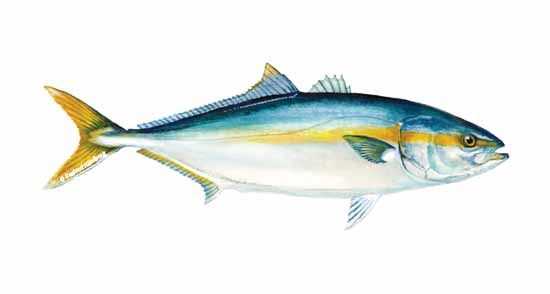Yellowtail Amberjack

Species Details
Seriola Lalandi
Carangidae
Perciformes
Offshore, Reef, Wreck
15 - 96 lbs.
22" - 98"
How big do Yellowtail Amberjack grow?
Yellowtail Amberjacks can reach impressive sizes. On average, they measure between 2 and 3 feet in length and weigh around 20 to 40 pounds. However, these powerful game fish have been known to grow even larger, with some individuals exceeding 5 feet in length and weighing over 100 pounds.
Yellowtail Amberjack (Seriola lalandi)
The Yellowtail Amberjack (Seriola lalandi) is a saltwater gamefish and a popular target for commercial and recreational fishers alike because it is easy to attract with practically any bait one would happen to have. You can easily distinguish a Yellowtail Amberjack from other fishes with its yellowish dorsal, pectoral, pelvic, anal, and caudal fins, which is where it gets its name from. Aside from the brightly colored fins, it generally has a long, slender body that has blue, bluish-green, or purplish-green hues on top and bright white to silver bellies.
Interesting Facts
- This fish species is prized in Japan because of its good-tasting oily meat, which is used for making sushi.
- Because of its popularity, Yellowtails are raised in fish farms in Japan, South Korea, and Australia.
- The biggest Yellowtail Amberjack caught by an angler on record is 8.2 feet long and weighs a little over 200 pounds.
- Fishing for Yellowtails was restricted throughout the 60s and 70s due to expansive commercial gill net fishing. The restrictions were lifted since then as the fish population is able to recover, thanks to the species’ long life expectancy and fast spawning.
Speed and Average Size
Yes, as mentioned earlier, the Yellowtail Amberjack can grow as long as eight feet and as heavy as two hundred pounds but don’t get your hopes too high as this species commonly grows between fifteen and twenty-five pounds. If, however, you’re lucky enough, you can maybe catch a forty pounder. Just a word of warning, though: Yellowtails are known to be fast and strong swimmers. So if you happen to hook a Yellowtail Amberjack, reeling it in will probably not be an easy task.
Habitat and Distribution
While the Yellowtail Amberjack can pretty much be found in tropical and temperate waters of the Pacific Ocean, it’s known to have high concentrations around Catalina and San Clemente Islands, in the Santa Monica Bay and off Long Beach, Newport Beach, Dana Point, and San Diego—especially during summers when the coastal waters are warm. They can also be found as far south as Baja California Sur in Mexico, with Cedros and Benitos Islands being spawning areas.
The Yellowtail Amberjack is a benthopelagic, which means it mostly lives and feeds near the bottom; although it can sometimes wander in midwaters or even near the surface in search of food. And for a higher probability of catching this species, it’s best that you cast your lines over kelp beds, rocky reefs, and other underwater structures as they are known to look in such areas for crustaceans, small fishes, and squids, which are their main diet.
Yellowtail Amberjack Fishing Tips
As we’ve mentioned, catching a Yellowtail isn’t that easy. You can, however, significantly up your chances of catching one (or even two) if you know the tricks. Here are some tips to help you catch a Yellowtail Amberjack:
- Yes, you can either use live or artificial bait, but for a higher probability of catching this fast fish, you’re going to be better off using live ones as its erratic movements can help attract this particular fish more.
- As Yellowtail Amberjacks commonly swims deep, you can coax them near the surface with chum.
- If you’re going for a larger (as we all go for, naturally) Yellowtails, you might want to use a heavy tackle so that it won’t easily break as this powerful fish struggles.
- Never reel in too fast and forcefully so that it won’t get too alarmed and try to struggle harder. Although, you have to watch out and not allow it to swim deeper into the reefs and other structures as it might snap your line.
- When reeling in this fish, you should wear gloves as holding the braid for too long can cause significant damage to unprotected hands.







